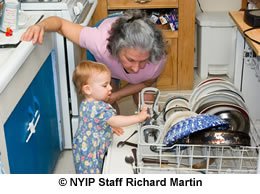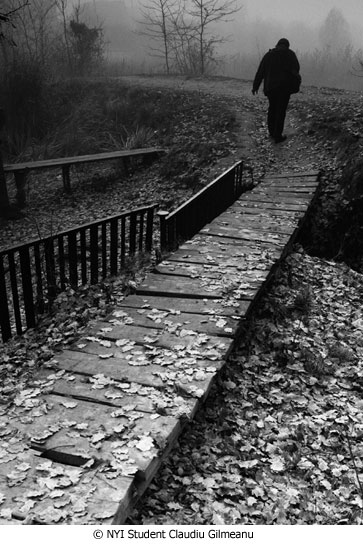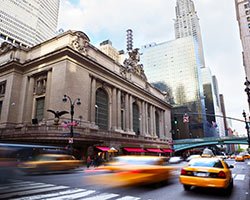The following article was written by Chris Armold, an NYI student who called the school to let us know that he'd photographed several campaign rallies. Since the call came in just before the Ohio and Texas primaries, I assumed he lived in one of those states. It turns out Chris is from Ohio and has been a working photographer for many years. He enrolled in our Complete Course in Professional Photography recently. If this seems surprising, it shouldn't be. Many experienced professionals got started on their own and decide at some point to study with NYI to consolidate their knowledge of photography and to fill in any gaps. Chris offered to write a "how to" article and we're pleased to run this informative piece accompanied by Chris's terrific photographs.
Election time is always a great photographic opportunity for national campaigns as well as statewide and local contests. Everything that Chris describes applies on every level. With the election season looking like it will stay in high gear through the conventions right up to the November general election, you can follow Chris's advice and take exciting photographs of possible Presidents, senators, governors, and their challengers - our your local campaigns.
Access is never as good as it is during campaign season. A few days ago, I watched President Bush arrive in New York City. Because of transportation concerns, Air Force One lands at JFK International and POTUS (the President of the United States) comes into Manhattan via Marine One, the Marine helicopter so designated because it's carrying the President. Marine One lands at the Wall Street Heliport, which is a block from my home. The security is unbelievable - police everywhere, police and Coast Guard boats in the East River, and the FDR drive shut down to whisk the President to his various stops. Coming in low from the east, the first helicopter arrives followed by two more (for decoy purposes). The second to land cuts a tight turn (bet POTUS isn't on that one, probably press corps), number three comes in from the south and a fourth streaks across the sky and departs. A few minutes later the motorcade comes out of the Heliport with two identical giant limousines. I didn't even take my camera out of my bag. There was no photograph from outside the security perimeter.
The next POTUS won't enjoy that security for some time. John McCain, Hillary Clinton, and Barack Obama are out there day after day, campaigning across the country. I know that after you read Chris's article, you'll want to take advantage of that opportunity.
Two last notes:
Chris told me he used a Nikon D300 to take these photographs, so the focal lengths that he quotes give a tighter view of the subject than they would if the photographer was using a 35mm SLR or a digital SLR with a 35mm-size sensor.
The NYI Photoworld Card that Chris mentions is supplied to all NYI students mid-way through the NYI Complete Course in Professional Photography. It is not a press card, it is a courtesy card. Press passes are issued by local police authorities. We provide full instructions to our students how to use a courtesy card - what it can do and what it can't do.
This is shaping up to be an exciting election season. Newly registered voters have created large voter turnout across the country. Regardless of whether you enter the fray as a photographer, don't fail to exercise your power as a citizen. As one New York politico says, "If you don't vote, don't bitch."
Photographing the 2008 Presidential Campaign
For Americans, election season brings out patriotism, excitement, and rhetoric. It demonstrates to the world the peaceful and fair transition of political power in the United States of America. For photographers, the four-year election cycle brings great opportunities to document the process while experiencing an insider's view of a national campaign. For NYIP students, election season is an excellent opportunity to stand side by side with local, national and international media photographers. It's a learning experience that can't be overstated.
But how do you get in the door? Who do you talk to? What's the protocol? What equipment should you bring?
For the purposes of this article, I relied exclusively on my NYIP New York PhotoWorld photographer ID as my sole credential and in the span of five days photographed three major figures in contemporary American politics: Barack Obama, Hillary Clinton and the 42nd President of the United State, Bill Clinton. If you've never photographed an event at this level, it's important to first realize that these political campaigns live and die with media coverage. They desperately want to get the words and images of their candidate in front of the American people and they realize that any media is good media. That's great news for you.
The first place to start is on the World Wide Web. Each candidate has a Web page which is updated daily with new events and appearance schedules. It's important to check these sites often as travel schedules and events can materialize quickly. Once you determine that an event is going to be held in your area, contact the state campaign office (there will be a link on the candidate's Web site) and let them know you're a photographer with New York Institute's PhotoWorld e-zine and that you'd like to cover the event. Most of those campaign media staffers ask for your e-mail address and then tell you the time the media will be permitted into the event. When you hear those words, you're halfway there. Just remember to bring your credentials to the event! If you gave the campaign staffer your e-mail address you'll almost certainly start getting a barrage of messages from the campaign telling you where so-and-so will be appearing in addition to who has endorsed who.
A typical event message will tell you what you need to know. The location of the event, what time it will start, what time the media can enter and what entrance is for the media. You may also see the term "throw" with a distance in feet such as "Throw 40 feet." This means the photographers' area is 40 feet from the podium. This is a good way to help determine what lens or lenses to bring along to ensure you can get good photographs.
What to wear is easy; the national media covering these folks is very laid back and the standard seems to be blue jeans and a comfortable shirt. I encourage you to make sure you're clean, well groomed and professional looking. No need for a suit, tie or dress, but look sharp. Don't forget extra batteries and other tools you'll need.
Protocol at these events is relaxed, but never forget that with politics at this level, law enforcement will be everywhere -- including the U.S. Secret Service. Obviously, it goes without saying that you need to check your attitude and politics at the door. Comments like "I'm here to shoot the candidate" will undoubtedly not be appreciated and are very unprofessional. Be polite, watch, look, and listen. If you need help, find a campaign staffer. Most staffers will have a little metal pin clipped to their lapel. These little pins are issued by the Secret Service so the agents can identify the staffers. The Secret Service guys will normally be in suits and will have a gold five-pointed star lapel pin. These professionals are extremely courteous, but remember, they are on the job so don't pester them.
If you've never done this before I'd encourage you to show up as soon as the media is permitted inside. Go to the media check-in table, simply show them your NYIP credentials and you'll be asked to sign in. Once you are permitted into the location where the candidate will be speaking, you'll normally find two areas reserved for television and photographers. The main photo riser will face the front of the podium and "the cut", a smaller area directly to one side of the stage, for profile photos and different photo perspectives. I personally prefer the cut but plan to take photos at each location.
Regarding camera equipment, I suggest you bring at least two lenses. First, a 50mm or a wide angle zoom lens to give you some "wide" shots of the event. Secondly, a telephoto lens. In my case I used my f/2.8 70-200mm telephoto lens for the majority of my photos. I also brought along a fisheye lens and a 20-35mm wide angle lens. You can also bring along your flash and don't forget your NYI monopod!
Once inside the venue look over the situation and prepare for getting great photos. Go to each of the media risers and see where you'd like to be. Be aware that often the "national media" usually have designated locations for camera positions. Don't waste time trying to figure out how to beat them to the spot, just find another location. You may have 90 minutes to turn up as you wait for the candidate to arrive, make it a productive time. Here are some suggestions on things to do.
Check the lighting out. Is it Tungsten or fluorescent? Are there additional spotlights that have not been turned on yet? Run through your mental checklist. It's important you get these photos because how often will you have a chance to potentially photograph a person who could be President of the United States? It's a pretty nice portfolio addition if you ask me. When spectators start to arrive most will position themselves directly in front of the podium. Take a few snaps of these people to help dial in your settings. Just be aware that lighting may change when the candidate steps on the stage. Often, however, there will be an introductory speaker and this will be your last chance to get a benchmark for your lighting.
Talk to other photographers. Once you're confident that you have your camera "dialed in", take a few moments to introduce yourself to some of the other people taking photos. Ask them who they are with and ask them if they've done this type of photography before. For the most part, the other photographers will represent local publications and you can learn a lot from these folks. One thing you may learn is that many of them have little or no formal photographic training. This is a great time to ask things like, "so what ISO are you using" etc. You'll find most photographers are very willing to "talk shop" especially with someone who is interested and wants to learn. I've been taking photos for almost 30 years and I learn things almost every time I talk with a fellow photographer.
Capture the Atmosphere. Without a doubt there will be interesting people to photograph who are in attendance. Signs, banners, flags, and bunting all add to the spectacle. Take photos that make it clear you're at a campaign rally! Some of these supporting photos can be very powerful.
Consider your Compositions. You'll pretty well know where the candidate will be speaking from, so start thinking "composition" now. Rehearse your photos look for interesting backgrounds that identify backdrops or angles that might add to the drama. Perhaps a slogan or flag in the background. Even when photographing a person who might one day be the President of the United States, remember the three basic guidelines touted in your NYIP course; have a clear subject, focus attention on the subject, and endeavor to simplify your image.
Now you're ready to photograph history. Just stay calm, take your time. Normally you can photograph the entire event so don't hesitate to review your photos as you shoot if you're shooting digital. Make adjustments and keep taking photos. At an event like this it's important to "get the photograph" so don't be stingy with the pixels! Once you're confident you've got some good basic portrait style photos then start working on making those compositions you envisioned a reality.
You really can do this. Have fun! You're going to love those photos in YOUR portfolio.






